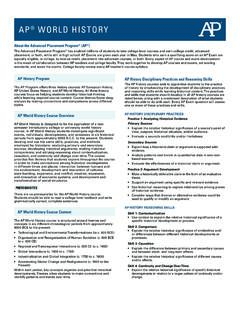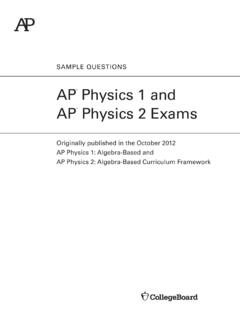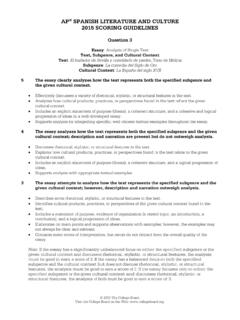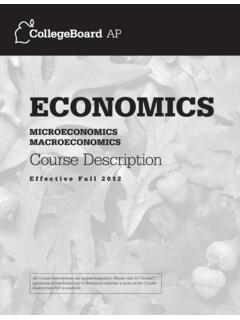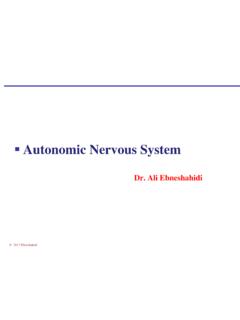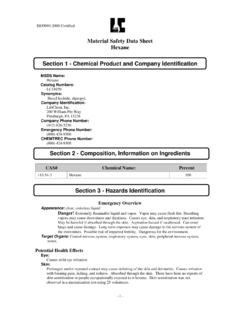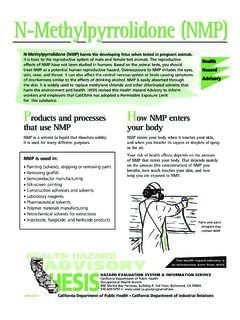Transcription of AP Biology 2007 Scoring Guidelines - College Board
1 AP Biology 2007 Scoring Guidelines The College Board : Connecting Students to College Success The College Board is a not-for-profit membership association whose mission is to connect students to College success and opportunity. Founded in 1900, the association is composed of more than 5,000 schools, colleges, universities, and other educational organizations. Each year, the College Board serves seven million students and their parents, 23,000 high schools, and 3,500 colleges through major programs and services in College admissions, guidance, assessment, financial aid, enrollment, and teaching and learning. Among its best-known programs are the SAT , the PSAT/NMSQT , and the Advanced Placement Program (AP ). The College Board is committed to the principles of excellence and equity, and that commitment is embodied in all of its programs, services, activities, and concerns. 2007 The College Board . All rights reserved. College Board , Advanced Placement Program, AP, AP Central, SAT, and the acorn logo are registered trademarks of the College Board .
2 PSAT/NMSQT is a registered trademark of the College Board and National Merit Scholarship Corporation. Permission to use copyrighted College Board materials may be requested online at: Visit the College Board on the Web: AP Central is the official online home for the AP Program: AP Biology . 2007 Scoring Guidelines . Question 1. Membranes are essential components of all cells. (a) Identify THREE macromolecules that are components of the plasma membrane in a eukaryotic cell and discuss the structure and function of each. (6 points maximum; 1 point for each macromolecule + structure, 1 point for each macromolecule + function). NOTE: Only first three molecules mentioned will be scored. Macromolecule Structure Function (must match selected macromolecule). Phospholipids OR Glycerol, two fatty acids, Selectively permeable and polar head group Lipid with phosphate w/phosphate Fluidity Amphipathic Creates compartment/. separates cell from Hydrophilic or polar (head) environment; barrier and hydrophobic or nonpolar (tails) Signals, inositol pathway (IP3).
3 Diacylglycerol (DAG). Forms a lipid bilayer Cholesterol Ring structure Moderates fluidity Steroid Stabilizes membrane Amphipathic Embedded in bilayer Proteins OR General Structure Transport The following specific types Polypeptides; amino acids Enzyme, catalysis must indicate that they are 2o , 3o , 4 o structure Signal transduction proteins description Integral Attachment: extracellular Peripheral matrix (ECM)-cytoskeleton Pump Specific Structure Recognition Receptor Transport Cell junction Integral, transmembrane, Recognition embedded; forms a Tight junction channel Desmosomes Gap junctions Peripheral, on surface Integrins Enzyme Structure fit to substrate Channel or ligand Glycolipid/Glycoprotein Carbohydrate (chains) Cell recognition linked to lipid/protein Attachment to external molecule or another cell 2007 The College Board . All rights reserved. Visit (for AP professionals) and (for students and parents). AP Biology . 2007 Scoring Guidelines . Question 1 (continued). (b) Explain how membranes participate in THREE of the following biological processes: (6 points maximum; 2 points maximum per section).
4 Muscle contraction Motor neuron or axon terminal releases neurotransmitter or acetylcholine (ACh). ACh binds to receptors Depolarization or Na + moves in through membrane channels or membrane depolarizes Action potential propagates along cell membrane (sarcolemma) or T tubules Depolarization changes permeability of sarcoplasmic reticulum (SR) or Ca 2 + released from SR. Ca 2+ active transport into SR (reuptake of Ca 2 + ). Repolarization or maintenance of membrane potential (Na + /K + pump). Smooth or cardiac muscle gap junctions directly transfer membrane potential between cells Fertilization of an egg Part of the acrosomal reaction or sperm acrosome releases hydrolytic enzymes (by exocytosis). Sperm binds to receptors on egg Fusion of sperm and egg plasma membranes Change in membrane electrical charge or fast block (depolarization) to prevent further fertilization (polyspermy). Cortical reaction or slow block by exocytosis (prevents polyspermy) or hardening of membrane Separation of fertilization membrane (envelope).
5 Fusion of egg and sperm nuclear membranes or nuclei Chemiosmotic production of ATP. Electron transport chain (ETC) in membrane pumps H + across membrane H + gradient established across membrane H + move through ATP synthase embedded in membrane to produce ATP. Membrane infolding increases surface area Intercellular signaling Release of chemical signals by exocytosis Receptors in membrane bind ligands or chemical signals or chemical signals pass through the membrane (examples: neurotransmitters, hormones, pheromones). Ligand-gated ion channels opening/closing Cascade of cellular events, including enzymatic reactions and second messengers (examples: G-proteins, cAMP, I P 3 , Ca 2 + ). Antibodies activate immune function Descriptions of gap junctions, plasmodesmata (communicating junctions). 2007 The College Board . All rights reserved. Visit (for AP professionals) and (for students and parents). AP Biology . 2007 Scoring Guidelines . Question 2. Cephalization and the development of a brain were important steps in animal evolution.
6 (a) Discuss the evolutionary origin and adaptive significance of cephalization in animal phyla. (3 points). Cephalization (1 point). Defined: The concentration of the nervous system toward the anterior end of the organism OR. Association: Cephalization tied to bilateral symmetry development Origin (1 point). Origin identification: (Platyhelminthes/flatworms). OR. Evolutionary progression of development Adaptive Significance/Advantage (1 point). Efficient response to a stimulus ( , protection, predation, avoidance, movement toward or away). During movement sensory organs encounter the environment first (b) Describe the development of the nervous system in the vertebrate embryo. (4 points maximum). Tissue of origin (1 point). o Ectoderm gives rise to the nervous system . Processes of development (2 points). o Neurulation described (neural tube formation) Note: The notochord does not become the nerve cord. o Other nerve development processes Neural crest cells migrate to form the peripheral nervous system Anterior portion of the neural tube/cord bulges to become the brain or brain regions Endpoints with structures described at the end of a process step of development (1 point).
7 O The ectoderm folds into the neural crest/tube or dorsal nerve/spinal cord o Neural tube expands or develops into developmental brain region ( , fore-mid-hind brain, prosen-mesen-rhombencephalon). o Spinal column/vertebrae/cranium that protects the CNS. Signaling (1 point). o Notochord (mesodermal in origin) signals or directs development of neural tube (ectodermal in origin). o Hox genes, morphogens (diffusible developmental signal). 2007 The College Board . All rights reserved. Visit (for AP professionals) and (for students and parents). AP Biology . 2007 Scoring Guidelines . Question 2 (continued). (c) At the sound of shattering glass, people quickly turn their heads. Discuss how the human nervous system functions to produce this tynme of response to an external stimulus. (5 points). Stimulus/Intermediating Structure of Receptor Action (1 point). Stimulus (sound waves, pressure, heat, etc.) producing an appropriate receptor action (eardrum vibrating, cochlear hairs vibrating or bending, pressure receptors firing, heat receptors firing, etc.)
8 Input/Sensory/Afferent (1 point). Signal direction toward the central nervous system Integration (1 point). Processing/Interpretation by CNS. Interneurons/Association/Communicating/I nternuncial Output/Motor/Efferent Response (1 point). Signal direction toward effectors (peripheral NS) or description of the response or autonomic nervous response ( , increase in blood pressure or heart rate, muscle contraction but not just turning of head). Possible Elaboration (1 point). Neural electrophysiology ( , action potential, neurotransmitters, synapse). Neuron structure and impulse pathway Sensory physiology 2007 The College Board . All rights reserved. Visit (for AP professionals) and (for students and parents). AP Biology . 2007 Scoring Guidelines . Question 3. Compared with other terrestrial biomes, deserts have extremely low productivity. (a) Discuss how temperature, soil composition, and annual precipitation limit productivity in deserts. (3 points maximum). Abiotic factor (description) How abiotic factor limits productivity (must be linked).
9 (1 point per factor). Temperature Increase in transpiration/evaporation Lowers photosynthetic rate Desiccation Lowers plant growth Loss of water from tissues/guard cells Lowers biomass production Not optimal temperatures PS/metabolic enzymes/proteins hindered Soil composition Low organic content/nutrients Lowers photosynthetic rate/plant growth Low water retention Lowers photosynthetic rate/plant growth Sandy Poor root anchorage limits plant growth Compacted soil Root limitations decrease photosynthesis Annual precipitation Low rainfall Little water available for photosynthesis Seasonal rainfall Lowers plant growth Period of high productivity/wildflowers Clear definition/discussion of productivity: , a measure of the amount of biomass produced by autotrophs/photosynthetic organism/plants amount of light energy converted to chemical energy by autotrophs per unit community productivity (1 point). (b) Describe a four-organism food chain that might characterize a desert community, and identify the trophic level of each organism.
10 (2 points). Written description of a minimum of 4 organisms (must include a producer/plant) (1 point). Clear identification of 4 distinct trophic levels of the organisms discussed (1 point). (producer primary consumer secondary consumer tertiary consumer or top carnivore or decomposer or scavenger). 2007 The College Board . All rights reserved. Visit (for AP professionals) and (for students and parents). AP Biology . 2007 Scoring Guidelines . Question 3 (continued). (c) Describe the results depicted in the graph. Explain one anatomical difference and one physiological difference between species A and B that account for the CO2 uptake patterns shown. Discuss the evolutionary significance of each difference. (6 points maximum). Graph interpretation (3 points). Describe graph (plant A takes up CO2 during day AND plant B takes up CO2 at night). (1 point). Species B as CAM (1 point). Species A as C3 or species A as C 4 (1 point). Anatomical difference (1 point). Species A is C 4 with bundle sheath/wreath/Kranz anatomy Stomata location (pits/crypts, underside stems) linked to CO2 uptake Stomata density linked to CO2 uptake In species B/CAM vacuole/mesophyll of organic acids (malate).
